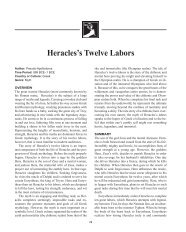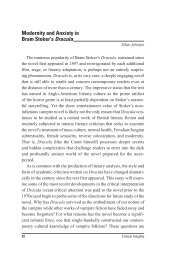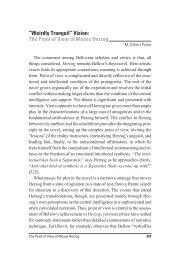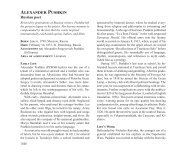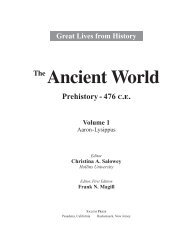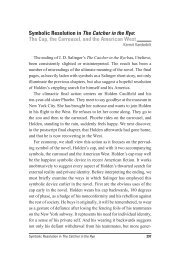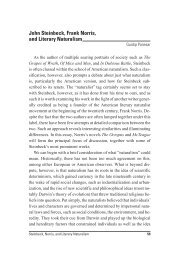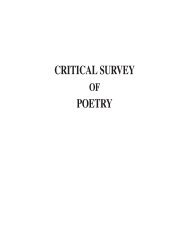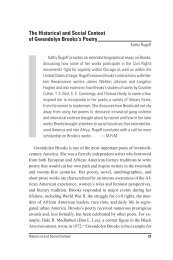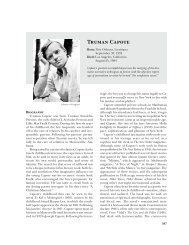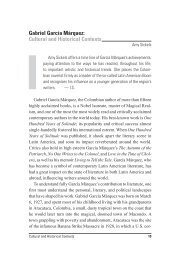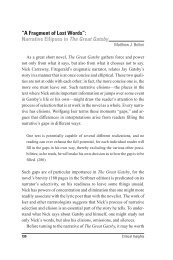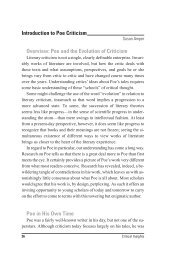THE OTTOMAN EMPIRE - Salem Press
THE OTTOMAN EMPIRE - Salem Press
THE OTTOMAN EMPIRE - Salem Press
Create successful ePaper yourself
Turn your PDF publications into a flip-book with our unique Google optimized e-Paper software.
The Ottoman Empire<br />
Dates: 1453-1923<br />
Political Considerations<br />
The Ottoman Empire, founded by Osman I (r. 1290-<br />
1326), dominated much of southeastern Europe, the<br />
Middle East, and North Africa between the fourteenth<br />
and early twentieth centuries. Ottoman military<br />
superiority in the Balkans in the fifteenth and<br />
sixteenth centuries stemmed from the use of new<br />
modern armaments integrating infantry and cavalry<br />
with innovative tactics. The Ottomans borrowed<br />
methods from their adversaries and even used Christian<br />
and Jewish soldiers and officers in their cam-<br />
587<br />
paigns. In addition to a magnificent army, they had a<br />
navy that was among the best in the Mediterranean<br />
area. However, one aspect of the early Ottoman success<br />
has been greatly exaggerated—that of the Ottomans’<br />
superiority in numbers. The Ottomans’ rapid<br />
conquest of the Christian, Greek-speaking, Eastern<br />
Roman Byzantine Empire, as well as the other Balkan<br />
states in the years from 1290 to 1453, came not<br />
from larger forces but from essentially waiting for<br />
their Christian rivals to destroy each other in battle<br />
and then moving in and taking over the remaining<br />
territory. The Ottoman sultans made alliances with<br />
Library of Congress<br />
The Ottoman Turks seize Constantinople from the Byzantines in 1453 to establish the Ottoman Empire.
588 Warfare in the Age of Expansion<br />
Ottoman Expansion Under Süleyman the Magnificent<br />
Spain<br />
Algeria<br />
Tunisia<br />
Ottoman Empire in 1520<br />
Sardinia<br />
Ottoman Empire at the end<br />
of Süleyman’s reign<br />
Venice<br />
Rome<br />
Tunis<br />
Holy<br />
Roman<br />
Empire<br />
Italy<br />
Sicily<br />
Mediterranean Sea<br />
Tripoli<br />
Hungary<br />
Bosnia<br />
Malta<br />
Vienna<br />
Serbia<br />
Poland<br />
Albania<br />
Transylvania<br />
Christian states, and Turkish soldiers served as mercenaries<br />
in Christian armies, just as Christians fought<br />
in the Turkish armies.<br />
National mythology has also greatly exaggerated<br />
the historical significance of key Ottoman victories<br />
before 1453, such as the defeat of the Serbs at Kosovo<br />
on June 15, 1389. In many ways the Ottomans inherited<br />
the Balkans by default, because the Byzantine<br />
army collapsed as a result of internal civil wars and<br />
external invasions by the Western European Christian<br />
Crusaders and other neighboring Christian states.<br />
The decisive victory that established the Ottoman<br />
domination of the Balkans was the Siege of Constantinople<br />
in 1453. The Turks had prepared for this battle<br />
for fifty years. According to legend, the city was to<br />
fall to a sultan bearing the name of the prophet Muwammad.<br />
Sultan Mehmed I (r. 1402-1421) initially<br />
appeared to be that man, but an internal contest for<br />
the throne and a war against Tamerlane in the east<br />
Wallachia<br />
Bucharest<br />
bulgaria<br />
Morea<br />
Crete<br />
Jedisan<br />
Istanbul<br />
Rhodes<br />
Tripoli Alexandria<br />
Egypt<br />
Khanate<br />
of the<br />
Crimea<br />
Black<br />
Sea<br />
Cyprus<br />
Cairo<br />
syria<br />
Aleppo<br />
Mesopotamia<br />
Red Sea<br />
Damascus<br />
Georgia<br />
Armenia<br />
Medina<br />
Mecca<br />
Iraq<br />
Caspian Sea<br />
Azerbaijan<br />
Tabriz<br />
Baghdad<br />
Luristan<br />
made his attack on the Byzantine capital impossible.<br />
However, when his grandson Mehmed II (1432-<br />
1481) ascended the throne in 1451, both sultan and<br />
people were ready.<br />
By 1453 Constantinople had become a shadow of<br />
its former self. The city’s population, which had once<br />
exceeded one million people, had declined to only<br />
several tens of thousands. Constantinople was no<br />
longer a unified city but rather a series of villages behind<br />
walls. Mehmed II prepared his attack carefully,<br />
building fortresses on both sides of the Bosporus—<br />
Anadolu Hisari on the Asian side and Rumeli Hisari<br />
on the European side—the ruins of which still stand.<br />
He strengthened the janissary corps, raising their<br />
pay and improving the officer ranks. He constructed<br />
causeways over the Galati hill north of the old city, so<br />
that he could have his ships dragged up and over to<br />
the Golden Horn, the harbor of Constantinople, circumnavigating<br />
the chain and flotilla that protected
The Ottoman Empire 589<br />
the entrance to the city’s vulnerable side. Mehmed’s<br />
fleet of 125 ships and an additional number of<br />
smaller support craft was five times larger than that<br />
of the Greeks. With this fleet, Mehmed prevented the<br />
Byzantines from bringing supplies by sea as they had<br />
done in the past. The first Turkish troops to reach the<br />
walls of Constantinople in April, 1453, were a few<br />
knights, who were successfully met by the Byzantine<br />
soldiers in a brief skirmish. Ottoman reinforcements<br />
then drove the Greeks back behind the walls. Massive<br />
Turkish forces gathered over the next days,<br />
including cavalry, infantry, engineers, and naval<br />
forces. Most important were the cannons Mehmed<br />
had placed at the heretofore impenetrable walls; they<br />
began a constant bombardment that continued for<br />
seven weeks until they finally breached the wall.<br />
Mehmed and his entourage of janissary soldiers,<br />
advisers, and imams, or religious leaders, took up their<br />
positions before the city. Mehmed offered the city either<br />
mercy if it surrendered without a fight, or pillage<br />
if it chose to fight. The Greeks chose to fight to the last.<br />
After the fall of Constantinople the Ottomans continued<br />
to expand throughout the Muslim world in the<br />
Near East and North Africa. At the height of the empire<br />
under the sultan Süleyman I the Magnificent<br />
(1494 or 1495-1566) the European boundaries<br />
reached beyond the Danube River to the gates of Vienna.<br />
Süleyman’s failure to take the Habsburg capital<br />
owed as much to the limitations of Ottoman military<br />
tactics, especially the definition of its campaigns by<br />
annual sorties lasting only from the spring to the fall,<br />
as it did to the defense of the Vien-<br />
nese. Süleyman also fought and lost<br />
to the naval forces of King Philip II<br />
of Spain (1527-1598) in the Mediterranean<br />
at the celebrated Battle of<br />
Lepanto (1571).<br />
After Süleyman the Ottoman Empire<br />
went into a decline. Succeeding<br />
sultans rarely left their palaces and<br />
placed state matters in the hands of<br />
their ministers, most of whom were<br />
Christian slaves taken in the child<br />
tax from Balkan families. The Ottomans<br />
fought against Austria, Poland,<br />
the Papacy, and other European<br />
Turning Points<br />
states for control of the Danubian plain for two hundred<br />
years. However, they found a European ally in<br />
France. In the late seventeenth century the grand viziers<br />
of the Albanian Köprülü family arrested the<br />
decline of the Ottoman Empire and spearheaded a revival<br />
of its former power. However, in 1664 at Szentgotthárd,<br />
on the Austrian-Hungarian border, the Ottomans<br />
suffered their first loss of land to the Christian<br />
powers. After the Thirty Years’ War (1618-1648) the<br />
improved European armies surpassed the Turkish<br />
army in organization, tactics, training, armament,<br />
and even leadership. The Turks, whose advanced<br />
techniques and equipment had previously been their<br />
strong points, now found themselves falling behind<br />
their adversaries in these areas.<br />
The Ottomans’ failure to take Vienna in a second<br />
attempt (1683) began the loss of their territory to the<br />
European powers. In the eighteenth century the empire<br />
lost wars and land to both Austria and Russia.<br />
Inside the empire local warlords carved out virtually<br />
independent fiefdoms throughout the imperial provinces.<br />
The sultan’s personal authority in reality did<br />
not extend beyond Constantinople. The grand janissary<br />
corps, which had gained the right to marry, were<br />
less an effective fighting force than a collection of sinecures.<br />
In 1792 Sultan Selim III (1761-1808) turned<br />
to France, the empire’s old ally, for assistance in<br />
modernizing Ottoman armed forces, creating a modern<br />
corps in addition to the janissaries. However, the<br />
French Revolution (1789-1799) and the Napoleonic<br />
Wars (1793-1815) interrupted the partnership. The<br />
1453 With use of large cannons, the Turks capture Constantinople from<br />
the Byzantines, establishing the Ottoman Empire.<br />
1571 The Battle of Lepanto II, fought between the Ottoman Turks and<br />
the Christian forces of Don Juan de Austria, is the last major<br />
naval battle to be waged with galleys.<br />
1792 Modern French military techniques and arms are introduced into<br />
Turkey.<br />
1826 The janissary corps are destroyed and the Turkish army is<br />
modernized.<br />
1923 The Treaty of Lausanne creates the Republic of Turkey, bringing<br />
the Ottoman Empire to its official end.
590 Warfare in the Age of Expansion<br />
The Ottoman Empire, c. 1700<br />
Portugal<br />
Morocco<br />
Spain<br />
France<br />
Algeria<br />
= Region of Ottoman rule<br />
Holy<br />
Roman<br />
Empire<br />
Tunisia<br />
Venice<br />
Rome<br />
Tunis<br />
Austria<br />
Tripoli<br />
Vienna<br />
Adriatic Sea<br />
Italy<br />
Tripoli<br />
empire suffered from internal revolutions, such as<br />
those by the Serbs and the Greeks, and from uprisings<br />
by warlords and rogue pashas such as Ali Pala (1741-<br />
1822), known as the Lion of Janina, in modern Albania,<br />
as well as wars with Russia and Persia. In a janissary<br />
revolt in 1806 Selim was dethroned and killed.<br />
His successor, Sultan Mahmud II (1785-1839), believed<br />
that the defeat of Napoleon would guarantee<br />
Ottoman territory at the Congress of Vienna (1814-<br />
1815), but when the Greek uprising of 1821 split the<br />
European alliance, Mahmud found himself at war<br />
against the combined forces of Russia, France, and<br />
England. In 1826, in order to modernize his forces, he<br />
did away with the janissaries.<br />
Mahmud’s successor, Abdülmecid I (1823-1861),<br />
allied himself to the powers by promising reforms in<br />
Hungary<br />
Balkans<br />
Greece<br />
M e d i t e r r a n e a n S e a<br />
Poland<br />
Constantinople<br />
Crete<br />
Aegean Sea<br />
Cyprus<br />
Palestine<br />
Alexandria Cairo<br />
Egypt<br />
Crimea<br />
Black Sea<br />
Syria<br />
Mesopotamia<br />
Damascus<br />
Red Sea<br />
Mecca<br />
Iraq<br />
Russia<br />
Caspian Sea<br />
Iran<br />
the treatment of his non-Muslim subjects. In the<br />
1830’s and 1840’s the powers protected Abdülmecid<br />
from a vassal revolt. In the 1850’s England and<br />
France joined Abdülmecid in the victorious Crimean<br />
War (1853-1856) against Russia. However, in 1877<br />
Russia again went to war against the Turks to aid a<br />
Balkan uprising. Although the Russians defeated the<br />
Turks and liberated the Christian states of the region,<br />
England, Turkey’s ally, prevented the Russian troops<br />
from taking Istanbul.<br />
In the early twentieth century the Young Turk<br />
Revolution brought constitutional government and<br />
more westernization to the empire. However, Turkey<br />
lost wars to Italy (1911) and to a coalition of Balkan<br />
states (1912-1913), only managing to regain a modest<br />
amount of European territory around Edirne in the
The Ottoman Empire 591<br />
Second Balkan War (May-June, 1913). After feeling<br />
betrayed by England and France, the Young Turk<br />
leaders turned toward friendship with Germany. After<br />
the outbreak of World War I in 1914, Turkey<br />
joined with the Central Powers in November of that<br />
year. Turkish troops faced the Russians in the Caucasus<br />
and the English in the Near East. The English had<br />
by then occupied Egypt and supported a revolt of the<br />
Arabs in Saudia Arabia and Palestine. With the collapse<br />
of Russia in 1917, the Turks received territory<br />
in the Caucasus, but the following year the Central<br />
Powers lost the war and the Allies divided up the territory<br />
of the empire among themselves.<br />
However, while the Allies occupied Constantinople,<br />
Mustafa Kemal (1881-1938), later named Atatürk,<br />
or Father of Turks, raised the standard of revolt<br />
in Ankara, where he set up a rival government.<br />
Kemal led the army to victory over the Greeks (1920-<br />
1922) and renegotiated the Treaty of Sèvres (1920) to<br />
his advantage in the Treaty of Lausanne (1923), creating<br />
the Republic of Turkey and bringing the Ottoman<br />
Empire to its official end.<br />
Military Achievement<br />
The Ottoman Empire in its early years successfully<br />
defeated the Christian powers of Europe and the Muslim<br />
states of the Near East. This success stemmed<br />
from the Ottomans’ innovative use of tactics and<br />
strategy integrating cavalry and infantry. The Ottoman<br />
cavalry, or sipahi (rendered in English as<br />
“spahi”), was drawn from the noble free-born Muslim<br />
class, whereas the infantry, the janissaries, were<br />
slaves of the sultan forcibly recruited from the children<br />
of conquered European peoples, converted to<br />
Islam, and trained as fierce fighters. There were also<br />
irregular cavalry and infantry troops. The Ottomans<br />
also did not hesitate, when it served their purposes, to<br />
use Christian or Jewish commanders, as well as<br />
Christian allies and mercenaries.<br />
The Muslims were among the first to effectively<br />
use cannon and gunpowder. Their success against<br />
European armies continued into the seventeenth century,<br />
when the decline of the empire began.<br />
Weapons, Uniforms, and Armor<br />
In the early centuries the Ottomans effectively used<br />
siege weapons and artillery, such as mortars, catapults,<br />
and large cannons, that fired both iron and<br />
stone shot. Mehmed II, also called Mehmed the Conqueror,<br />
wished to have the most modern weapons and<br />
ordered a Hungarian gunsmith to build him large<br />
cannons, one of which was used at Constantinople,<br />
that could fire 1,200-pound cannonballs. Janissaries<br />
used scimitars, knives, stabbing swords, battle-axes,<br />
and harquebuses. The Turks were also skilled marksmen<br />
using muskets. Ottoman archers continuously<br />
rained arrows on the defenders of cities they attacked.<br />
The Ottomans were renowned for their<br />
sappers as well, who attacked the enemy’s fortifications<br />
with axes. The spahi cavalry, true medieval<br />
warriors, carried bows, swords, lances, shields, and<br />
maces. The Ottoman navy consisted of corsairs and<br />
oared galleons.<br />
The Turks established local janissaries and other<br />
regional corps in different parts of the empire, each<br />
with its own distinct uniforms, pennants, and standards.<br />
The traditional Ottoman uniforms consisted of<br />
short, loose pantaloons, a short shirt with a large sash,<br />
a high turban, stockings that reached above the hem<br />
of the pantaloons, and Turkish-style slippers. Janissaries<br />
also wore long, flowing robes and felt hats.<br />
The akhis, or officers, wore pantaloons, sashes,<br />
capes, red boots, long fur-trimmed robes, and tall,<br />
elaborately carved, large-plumed helmets whose<br />
height depended on the wearer’s rank. Janissary food<br />
bearers wore black uniforms, sandals, pantaloons,<br />
short jackets with long sleeves, half-vestlike shirts,<br />
and conical hats. The sultans rode on caparisoned, or<br />
decoratively adorned, horses and carried bejeweled<br />
weapons.<br />
The janissaries’ standard was the scarlet crescent<br />
and double-edged sword symbol of Osman, the<br />
founder of the Ottoman dynasty. The akhis carried<br />
staffs with tails representing the sleeve of the sheik of<br />
the Bektashi dervishes, the janissaries’ religious order.<br />
The number of tails on the akhi’s staff depended<br />
on his rank. The janissaries’ staff bore a spoon symbolizing<br />
their higher standard of living. The insignia<br />
of the janissary corps was the soup pot and the spoon.
592 Warfare in the Age of Expansion<br />
Officers bore titles from the kitchen such as the First<br />
Maker of Soup, First Cook, and First Water-Bearer.<br />
The soup pot was the sacred object around which the<br />
janissaries gathered to eat or discuss events and policies.<br />
In rebellions they traditionally overturned these<br />
soup pots.<br />
In the seventeenth and eighteenth centuries Turkish<br />
armament lagged behind the times. In 1796 the<br />
French ambassador General Jean-Baptiste Aubert-<br />
Dubayet brought to Turkey several pieces of modern<br />
armament and artillery as models for the Turks to<br />
copy and French engineers and artillery officers to<br />
teach the Turks modern methods. In the nineteenth<br />
and twentieth centuries the Ottoman Empire continued<br />
to modernize its forces and weaponry. Before<br />
World War I the Germans improved upon Turkish<br />
arms. German General Otto Liman von Sanders<br />
(1855-1929) came to Turkey to oversee the training<br />
of troops. During the war the Turks had excellent<br />
gunnery. However, two battleships ordered from England,<br />
which were to be the best of the fleet, had not<br />
been delivered before the Turks joined the Central<br />
Powers and were confiscated by the British. In the<br />
late nineteenth century the Turks adopted typical European<br />
khaki winter and summer army and blue navy<br />
uniforms. For officers, the fez—a brimless, flatcrowned<br />
hat—replaced the turban.<br />
Military Organization<br />
Within the Ottoman Empire the government and the<br />
military were closely linked. The empire was divided<br />
into two parts: European and Asian, each governed<br />
by aghas, area governors who administered the empire<br />
in the name of the sultan. Under the aghas stood<br />
the provincial governors, or sanjak beys. The sanjak,<br />
which has come to mean “province,” was literally the<br />
standard of the governor, or bey. In 1453 there were<br />
twenty sanjaks in Asia and twenty-eight in Europe.<br />
The sanjak beys commanded troops, operated the policing<br />
powers in their provinces, and collected taxes.<br />
Within the sanjaks there were two types of agricultural<br />
estates: large zaimets and smaller timars. Ottoman<br />
theory held that all land belonged to God and<br />
was managed by the sultan; the managers of these es-<br />
tates were free-born Muslim noblemen. The spahis,<br />
knights who served as the cavalry of the Ottoman armies,<br />
were the most numerous Ottoman warriors.<br />
The early sultans gave most of the land they conquered<br />
to these warriors, although a minor portion<br />
was reserved for government and diplomatic officials.<br />
The peasants, called rayah, literally “cattle,”<br />
were the serfs who worked the land. The other governing<br />
functions were handled by the various Muslim,<br />
Christian, and Jewish religious authorities who<br />
ruled their own communities.<br />
The Ottomans used both regular and irregular<br />
troops as police forces. The two most important regular<br />
land forces were the janissary infantry corps and<br />
the spahi knights. The Ottoman navy was a supplementary<br />
force that often carried janissary troops, as<br />
well as naval officers and sailors.<br />
The janissaries were Christian and Jewish boys, as<br />
young as seven years old, periodically gathered in the<br />
Balkans through a child tax, called devshirme. Girls<br />
were also gathered to serve in various harems. Sultan<br />
Orhan (c. 1288-c. 1360) started the corps as a bodyguard,<br />
and Murad I (c. 1326-1389) developed it as a<br />
militia to guard the European territories. The boys<br />
were selected for the janissary corps based on their<br />
strength and intelligence. They were educated as<br />
Muslim Bektashi dervishes, the religious order favored<br />
by Ohran, and housed in barracks at Bursa. After<br />
the fall of Constantinople in 1453, Mehmed II<br />
moved the main janissary barracks to the sultan’s<br />
palace in the capital. During battle, conquered fortresses<br />
served as their barracks, and local produce<br />
served as their food.<br />
Aminority, approximately 15 percent, of the most<br />
intelligent children were selected for government<br />
and diplomatic service, while the remainder were<br />
trained for the janissaries. The boys were educated in<br />
the palace school, where they studied subjects such<br />
as Turkish history, Muslim literature, and romantic<br />
and martial music. They practiced gymnastics and<br />
sports on both foot and horseback to increase their<br />
strength and agility. The students became expert<br />
in archery, swordsmanship, javelin throwing, and<br />
riding.<br />
Early janissaries could not own property, marry,<br />
or perform other service, but they were armed and
The Ottoman Empire 593<br />
well paid and had a strong esprit de corps. They were<br />
the most respected infantry in Europe: fearless, well<br />
trained, dedicated troops with intelligent and coolheaded<br />
commanders. At the dedication of the corps,<br />
the sheik of the Bektashi, an officer of the corps,<br />
promised, “Its visage shall be bright and shining, its<br />
arm strong, its sword keen, its arrow sharp-pointed. It<br />
shall be victorious in every battle and will never return<br />
except in triumph.” The janissaries were known<br />
for their military discipline, which rivaled that of the<br />
ancient Greeks and Romans.<br />
In contrast to the “inside aghas,” who were leaders<br />
of the government and palace service, the chief janissary<br />
officers held the title of “outside aghas.” In the<br />
time of Mehmed II they numbered a force of ten thousand.<br />
They were unique in Europe, where most armies<br />
consisted almost completely of cavalry. The<br />
janissaries were commanded only by aghas, who had<br />
been appointed by the sultan, and the provincial beys<br />
and pashas had no authority over them.<br />
When the Ottoman Empire went into decline, the<br />
Republic of Turkey, 1923<br />
GREECE<br />
Crete<br />
Izmir<br />
Mediterranean Sea<br />
Republic of Turkey in 1923<br />
Istanbul<br />
ANATOLIA<br />
Antalya<br />
janissary corps began to deteriorate. Muslims were<br />
recruited into the janissaries, affecting the traditional<br />
camaraderie. Janissaries also worked as artisans to<br />
supplement their income. During Süleyman’s reign,<br />
they received the right to marry, and their sons began<br />
entering the corps, first through loopholes in the law<br />
and later through quotas. Nepotism grew rampant.<br />
Murad IV (1612-1640), recognizing the de facto<br />
practice, abolished the devshirme. Janissaries often<br />
paid others to serve in the field in their place, while<br />
still collecting their pay and enjoying their privileges.<br />
The corps, if they disagreed with the imperial policies,<br />
would often mutiny in the field or in Constantinople.<br />
The janissaries began to influence politics as<br />
early as the fifteenth century, when they backed the<br />
sultan Mehmed I against his brothers, but in the seventeenth<br />
century the corps became stronger than the<br />
sultan. Sultans and ministers curried favor with the<br />
janissaries as well as the spahis through promotion<br />
and pay raises.<br />
Black Sea<br />
Cyprus<br />
REPUBLIC<br />
OF<br />
TURKEY<br />
SYRIA<br />
Erzerum<br />
Kur ds<br />
ARMENIA<br />
IRAQ<br />
RUSSIA<br />
PERSIA
594 Warfare in the Age of Expansion<br />
The vizier Köprülü Amca-z3de Hüseyin (died<br />
1702) tried to reverse the downward trend by revising<br />
the muster roles of the janissaries, improving military<br />
equipment for both the janissaries and the navy,<br />
building new barracks, and refurbishing the imperial<br />
defenses, but the measures proved to be only temporary.<br />
The Ottoman forces also included renowned artillery<br />
and engineering units and highly skilled artisans<br />
who were supported through a guild system.<br />
These artisans supplied the Ottoman armies and<br />
maintained their morale and standard of living.<br />
The Turkish sipahi cavalry were considered to be<br />
without peer. They were ready at any moment on the<br />
command of the sanjak beys to leave their fields and<br />
join in battle. Failure do so would mean loss of their<br />
position. Although the ranks were not hereditary, the<br />
son of a deceased spahi might be given a small<br />
amount of land for his needs. He would then have to<br />
prove himself in battle to earn a tamir or zaimet.<br />
There were also mounted soldiers at a lesser rank<br />
than spahi, and the spahis of the Porte in Constantinople,<br />
“the men of the sultan,” who formed a separate<br />
corps. In the seventeenth century the number of feudal<br />
spahis dwindled, and, like the janissaries, the<br />
spahi also began to hire substitutes, some of whom<br />
were unscrupulous adventurers. Spahis were no longer<br />
suited for all-year duty against the modern European<br />
artillery. At the Battle of Mezö-Keresztes<br />
(1596) against Hungary they left the field en masse.<br />
The sultan dismissed thirty thousand spahis, turning<br />
a large group of nobles into landless malcontents and<br />
further increasing the problems of the empire.<br />
In times of war the Ottoman Empire employed a<br />
supplemental irregular cavalry, the akinjis. Other irregular<br />
troops were the azab corps, a reserve infantry<br />
founded by Orhan. The sixteenth century governor of<br />
Bosnia used another irregular force to police his<br />
sanjak. These irregular troops did not receive regular<br />
pay but were rewarded with spoils of war. However,<br />
jealous of the pay and privileges of the regular forces,<br />
they sometimes rebelled.<br />
In the seventeenth century the Ottoman Empire<br />
also fell behind in inventory and supply. While the<br />
great powers of Europe established modern professional<br />
armies in the sixteenth and seventeenth centuries,<br />
the sultans stubbornly held on to their antiquated<br />
traditional techniques. They lacked modern financing<br />
procedures and an industrial system based on<br />
flexibility, free enterprise, and competition that was<br />
required for modern warfare. Pillaging and living off<br />
the land no longer sufficed. The haphazard Turkish<br />
system of taxes and economic restrictions held the<br />
empire’s military behind while its European enemies<br />
forged ahead. Furthermore, the janissaries and artisan<br />
guilds joined together to protect their traditional<br />
privileges and maintain the military’s traditional procedures.<br />
In the eighteenth century all aspects of the army—<br />
training, discipline, armament, fortifications, field<br />
maneuvers—fell to a substandard state. Incompetence<br />
and ignorance ruled even in the most elementary<br />
matters. Open defiance and mutiny were rampant<br />
among the troops. Theft of supplies by both<br />
officers and soldiers was common. Janissaries often<br />
did not go on campaign but hired people in their<br />
stead. Janissaries would fight with their officers or<br />
demand privileges reserved for officers. The corps<br />
became a parasitic burden, a shadow of the unbeatable<br />
force it had been in its early days.<br />
After a loss to the Russians in 1792, Sultan Selim<br />
III was anxious to reform his army. Although Selim’s<br />
many reforms were not limited to military matters,<br />
an overhaul of the army played a key part in his<br />
plans. Selim looked to France, where the French<br />
Revolution of 1789 had brought about a new order.<br />
He sent special ambassadors to the courts of Europe<br />
and studied their detailed reports. He was particularly<br />
interested in guns and artillery, about which<br />
he himself had written a treatise. He was especially<br />
impressed with the revolutionary French army and<br />
requested help from Paris to improve the Turkish<br />
military. The French experts improved Turkish gun<br />
foundries, arsenals, and equipment. In both the army<br />
and navy they taught the Turks gunnery, fortifications,<br />
navigation, and related subjects. The Turkish<br />
engineering school was brought up to modern standards.<br />
However, the sultan’s advisers were divided.<br />
Some insisted on maintaining the old Turkish ways at<br />
any cost, whereas others advocated the Western techniques<br />
only to restore the past Turkish glory; still<br />
others called for a complete overhaul of the Turkish
The Ottoman Empire 595<br />
military and society in the Western manner. Selim established<br />
the Topiji—a small force of prisoners, European<br />
deserters, and poor Muslims—and had them<br />
trained in the Western fashion as a prototype army.<br />
Impressed by the Topiji’s superiority, Selim tried to<br />
introduce their methods and arms into the Turkish<br />
forces. The spahis accepted the new methods, but the<br />
janissaries continued to resist modernization. Selim<br />
thus enlarged the Topiji force, which by then included<br />
some of the French officers who had remained<br />
in Turkey. In 1805 he introduced a draft but<br />
was assassinated the following year in a janissary revolt.<br />
Mahmud II then ascended the throne.<br />
The success of Mehmed Ali of Egypt in building a<br />
Western army with Muslims encouraged Mahmud to<br />
do away with the janissaries and rely solely upon the<br />
new army. Mahmud replaced the European officers<br />
F. R. Niglutsch<br />
The British defeat of the Ottoman fleet at the Battle of Navarino Bay in 1827 effectively destroyed the Ottoman<br />
navy and paved the way for Greek independence.<br />
training the troops with Muslims and ordered 150<br />
troops from each janissary battalion to join the new<br />
corps. On June 15, 1826, as expected, the janissaries<br />
revolted, overturning their soup pots and invading<br />
the palace. Mahmud was ready. He had increased his<br />
loyal artillery troops, placing them in strategic points<br />
in the streets. They drove the rebels back to their barracks,<br />
where they barricaded themselves and were<br />
destroyed by artillery in less then an hour. More than<br />
six thousand died in the shelling. Mahmud executed<br />
the surviving leaders, disbanded the corps, and outlawed<br />
the Bektashi dervish religious order. The remaining<br />
janissaries were exiled to Asia.<br />
After the destruction of the janissaries, Mahmud<br />
reintroduced the old title serasker; originally held by<br />
a high commander of general rank, it was now given<br />
to the commander in chief who also served as minis-
596 Warfare in the Age of Expansion<br />
ter of war and handled police duties in Constantinople.<br />
He paid special attention to the new army.<br />
Twelve thousand men were stationed at Constantinople<br />
and elsewhere in the provinces. Mahmud turned<br />
to England and Prussia for assistance training the<br />
new army. Officers were sent to England, and British<br />
officers came to Turkey. Prussia sent Lieutenant<br />
Helmuth von Moltke (1800-1891), who later became<br />
an architect of Prussia’s renowned army, as a military<br />
adviser. Von Moltke helped to modernize the Ottoman<br />
Empire’s defenses and to train and organize the<br />
new troops. He was dissatisfied, however, with<br />
Mahmud and the Ottoman army, who resisted instruction<br />
from foreigners. Turkey and Prussia exchanged<br />
cadets and officers as well, establishing a<br />
German tradition that would continue through the<br />
life of the empire.<br />
In the 1840’s the army was reorganized into active<br />
and reserve units, and the term of active service was<br />
reduced from twelve to five years. Soldiers who had<br />
actively served for five years would serve the balance<br />
of seven years in their home provinces as reserves.<br />
The military was further reorganized along Western<br />
lines, the number of troops was increased to 250,000,<br />
and military schools were established.<br />
In 1808 the Young Turk Revolution brought German<br />
trained officers forward. Enver Pala (1881-<br />
1922), one of the leaders of the revolt, had trained in<br />
German methods as a young officer and now went to<br />
Berlin as military attaché. The war minister Sevket<br />
Pala (1858-1913) actually trained in Germany. Thus,<br />
the German influence that had existed since the time<br />
of Mahmud actually increased during the nineteenth<br />
century.<br />
After the Young Turk Revolution, the use of officers<br />
in government positions reduced the efficiency<br />
of the army and navy in the field. Furthermore, capable<br />
officers opposed to the government were sent to<br />
distant posts. The defeats of the Italian and Balkan<br />
Wars impressed upon the new leaders the need for<br />
massive reform. Enver Pala, who by that time had<br />
become one of the ruling triumvirate along with<br />
Mehmed Talât Pala (1872-1921) and Ahmed Cemal<br />
Pala (1872-1922) took this in hand. Much of the<br />
problem was the mistrust that the older officers had<br />
of the young military supporters of the revolution, a<br />
situation that demanded a general purge of the senior<br />
officers. Sevket Pala recognized the problem but refused<br />
to dismiss his friends in the officer corps.<br />
Therefore Enver Pala took over the ministry and convinced<br />
the reluctant Sultan Mehmed V (1844-1918)<br />
to issue a decree retiring officers over fifty-five years<br />
of age. A new agreement with Berlin brought forty<br />
German officers to Turkey. They were led by Liman<br />
von Sanders, who was placed in charge of the first<br />
army in Constantinople.<br />
Doctrine, Strategy, and Tactics<br />
From the early days of the Ottoman Empire, the doctrine<br />
of warfare called for the conquest of Muslim<br />
and Christian land in the name of God. In fact, all of<br />
the empire’s territory was seen to be God’s land, administered<br />
by the sultan through aghas, beys, and pashas,<br />
military leaders as well as government officials.<br />
When the Ottoman sultans became the rulers of the<br />
Muslims of the Near East, they revived the old title of<br />
caliph, for the religious leader of Islam.<br />
The Ottoman strategy was simple. On yearly campaigns,<br />
which, after 1453, began from Constantinople<br />
in a formal ceremonial military parade and lasted<br />
until late fall, their well-trained and courageous armies<br />
fought and conquered as much land and as<br />
many cities as they could. Victims who acquiesced<br />
were shown mercy. Those who resisted suffered a<br />
brief period of brutal pillage. In the fifteenth and sixteenth<br />
centuries the Ottomans managed the lands under<br />
their control well. Even non-Muslim communities<br />
had a great deal of autonomy. In the later<br />
centuries, inefficient government and arbitrary actions<br />
of virtually independent warlords, landlords,<br />
and local beys and pashas inflicted hardship.<br />
The Ottomans learned from their adversaries,<br />
studying Western military forces and strategies. After<br />
the seventeenth century the viziers, more often<br />
than the sultan, marched on campaigns and sometimes<br />
participated in battles. Although the army was<br />
the main force, a flotilla of hundreds of boats accompanied<br />
the troops on the rivers of the region under attack.<br />
Atypical order of battle in the open field consisted
The Ottoman Empire 597<br />
of three armies. For example, at Kosovo Field in<br />
1389, Sultan Murad I commanded the center with his<br />
janissary corps and spahi knights. By tradition the<br />
army of the region where the battle was fought occupied<br />
the right flank. Thus Bayezid I (c. 1360-1403),<br />
the sultan’s son and heir, led the army of Europe on<br />
his right. A younger son led the army of Asia on the<br />
left flank. At Kosovo an advance guard of two thousand<br />
archers began the attack. However, the standard<br />
Ottoman practice was to begin battle with an inferior<br />
line of irregulars. The janissaries would attack accompanied<br />
by drums and cymbals and exhorted by<br />
their non-janissary brothers of the Bektashi der-<br />
vishes. If the enemy forces outnumbered the Turks,<br />
the strategy changed, and the Ottomans would wait in<br />
hiding for the battle to begin.<br />
The Ottoman forces, well suited for siege warfare,<br />
used both cannons and mines. They dug trenches<br />
about 1,500 meters from the besieged city walls and<br />
set up their artillery behind the ridges. Archers then<br />
continually rained arrows on the city, while janissaries<br />
scaled the walls. The Turks were willing to continue<br />
a siege as long as it took for a city to surrender or<br />
fall. They often gave generous terms of surrender, allowing<br />
those who wished to leave the city to go<br />
freely.<br />
Contemporary Sources<br />
The best primary sources on the military history of the Ottoman Empire available in English<br />
and held in American libraries are memoirs and contemporary accounts of battles. Among the<br />
best of the former are the memoirs of Sir Edwin Pears (1835-1919), Forty Years in Constantinople:<br />
The Recollections of Sir Edwin Pears, 1873-1915 (1916), Evliya Çelebi’s (c. 1611-c. 1682)<br />
Travels in Palestine (1834), and Konstanty Michalowicz’s (born c. 1435) Memoirs of a Janissary<br />
(1975), an account of a fifteenth century Turkish warrior found in the microform collection<br />
of the University of Michigan. The University of Michigan is the repository of numerous eyewitness<br />
accounts of Turkish-Western battle, a number of which have been published. Suraiya<br />
Faroqhi’s Approaching Ottoman History: An Introduction to the Sources (1999) is a general<br />
survey of sources in Turkish and other languages.<br />
Books and Articles<br />
Aksan, Virginia. “Ottoman War and Warfare, 1453-1812.” In European Warfare, 1453-1815,<br />
edited by Jeremy Black. New York: St. Martin’s <strong>Press</strong>, 1999.<br />
_______. Ottoman Wars, 1700-1870: An Empire Besieged. Harlow, England: Longman/<br />
Pearson, 2007.<br />
Almond, Ian. “Muslims, Protestants, and Peasants: Ottoman Hungary, 1526-1683.” In Two<br />
Faiths, One Banner: When Muslims Marched with Christians Across Europe’s Battlegrounds.<br />
Cambridge, Mass.: Harvard University <strong>Press</strong>, 2009.<br />
Faroqhi, Suraiya. “The Strengths and Weaknesses of Ottoman Warfare.” In The Ottoman Empire<br />
and the World Around It. New York: I. B. Tauris, 2004.<br />
Gabriel, Richard A. The Siege of Constantinople. Carlisle, Pa.: U.S. Army War College, 1992.<br />
Goodwin, Godfrey. The Janissaries. London: Saqi, 1992.<br />
Guilmartin, John F., Jr. “Ideology and Conflict: The Wars of the Ottoman Empire, 1453-1606.”<br />
In Warfare and Empires: Contact and Conflict Between European and Non-European Military<br />
and Maritime Forces and Cultures, edited by Douglas M. Peers. Brookfield, Vt.:<br />
Ashgate/Variorum, 1997.<br />
Imber, Colin. The Ottoman Empire, 1300-1650: The Structure of Power. New York: Palgrave<br />
Macmillan, 2002.<br />
Murphey, Rhoads. Ottoman Warfare, 1500-1700. New Brunswick, N.J.: Rutgers University<br />
<strong>Press</strong>, 1999.
598 Warfare in the Age of Expansion<br />
Nicole, David. Armies of the Ottoman Turks, 1300-1400. Botley, Oxford, England: Osprey,<br />
1985.<br />
Reid, James J. Crisis of the Ottoman Empire: Prelude to Collapse, 1839-1878. Stuttgart, Germany:<br />
Steiner, 2000.<br />
Turfan, M. Naim. Rise of the Young Turks: Politics, Military, and Ottoman Collapse. London:<br />
I. B. Taurus, 1999.<br />
Turnbull, Stephen. The Ottoman Empire, 1326-1699. New York: Routledge, 2003.<br />
Zorlu, Tuncay. Innovation and Empire in Turkey: Sultan Selim III and the Modernisation of the<br />
Ottoman Navy. New York: Tauris Academic Studies, 2008.<br />
Films and Other Media<br />
Lawrence of Arabia. Feature film. Columbia Pictures, 1962.<br />
The Ottoman Empire: The War Machine. Documentary. History Channel, 2006.<br />
The Ottoman Empire, 1280-1683. Documentary. Landmark Films, 1995.<br />
Suleyman the Magnificent. Documentary. National Gallery and Metropolitan Museum of Art,<br />
1987.<br />
Frederick B. Chary
Literature and Warfare<br />
Overview<br />
War is life’s greatest conflict and the ultimate form of<br />
competition. As such, it continues to provide writers<br />
with a fertile field for examining the always intriguing<br />
complexities of human nature. Warfare is often railed<br />
against, and on occasion it has been chic to view it as<br />
obsolete. In the overall scheme of things, however,<br />
war has generally managed to remain popular. Indeed,<br />
the noted philosophers Will and Ariel Durant once<br />
calculated that in the past 3,000 years only 268 of<br />
those years have been free of war. With this in mind,<br />
it is perhaps not surprising that wars have provided<br />
grist for some of the world’s most enduring literature.<br />
Significance<br />
Literature that focuses on war recognizes how war<br />
affects human behavior through characters created in<br />
literature.<br />
History of Literature<br />
and Warfare<br />
Ancient World<br />
Organized armies have fought against each other for<br />
at least ten thousand years. Either at war or in anticipation<br />
of war, military infrastructures have played a<br />
key role in the organization of human societies. The<br />
earliest civilizations of China, for example, were established<br />
by organized armies.<br />
Accounts of the earliest conflicts were preserved<br />
in song and story through oral tradition, often setting<br />
warfare in a mythological context. Rigvedic hymns<br />
of ancient India, for instance, relate tales of the warrior<br />
god Indra. A Babylonian epic poem, “War of the<br />
Gods,” deals with the myth of world creation and the<br />
establishment of divine hierarchy, which formed part<br />
of a New Year’s festival.<br />
873<br />
The earliest literary work in the Western tradition<br />
to deal with war is found in the Iliad (c. 750 b.c.e.;<br />
English translation, 1611), ostensibly written by<br />
Homer (c. 750 b.c.e.), but whether or not it is a work<br />
of shared authorship is a moot point. One of the classics<br />
of world literature, the Iliad deals with the very<br />
long and savage war between Athens and Sparta—<br />
the Trojan War (c. 1200-1100 b.c.e.)—with the culminating<br />
siege of Troy, which dragged on for three<br />
decades. The war was originally based on a struggle<br />
for control of important trade routes across the<br />
Hellespont. However, in the Iliad, the story centers<br />
on one incident: the Trojans’ attempt to recover the<br />
abducted Helen of Troy. When Agamemnon—king<br />
of the Greeks (who invade Troy), refuses to ransom<br />
Chryseis to her father, the god Apollo inflicts a<br />
plague of pestilence on them, compelling Agamemnon<br />
to return the girl. Not to be entirely thwarted, Agamemnon<br />
takes Achilles’ prized concubine instead.<br />
Dishonored, Achilles withdraws his warriors. War<br />
here is depicted as not only mean and bloody but also<br />
a process of retaliation and quid pro quo. During this<br />
process, when a warrior is slain or an attack is perpetrated,<br />
the fury of the combatants escalates. Such<br />
endlessly escalating conflict required a resolution,<br />
and Homer offered one in the Odyssey (c. 725 b.c.e.;<br />
English translation, 1614), which tells the story of a<br />
survivor of the Trojan War, Odysseus (or Ulysses),<br />
who undergoes a series of adventures that function as<br />
tests and atonements before he can return home to a<br />
joyful reunion with his wife, Penelope. Both the Iliad<br />
and the Odyssey draw heavily on the rich storehouse<br />
of Greek mythology, and in so doing provide a “divine”<br />
perspective on the issues of loss and redemption<br />
surrounding the Greek view of war.<br />
In the Aeneid (29-19 b.c.e.; English translation,<br />
1553), war is the context for nation-building: The<br />
Roman poet Vergil (Publius Vergilius Maro) uses literature<br />
as a sort of genealogical tool to reconstruct<br />
the beginnings of the Roman Empire. In this epic<br />
poem, the Greek warrior Aeneas has fled his native
874 Culture and Warfare<br />
land following the Trojan War and—after a series of<br />
adventures, some harrowing—arrives in Italy, where<br />
he proceeds to recount the details of the Trojan War.<br />
After defeating the Rutulian leader Turnus in battle<br />
and miraculously recovering from a wound received<br />
in combat, Aeneas marries Lavinia (daughter of<br />
Latinus, king of the Latins) and establishes the new<br />
kingdom on the Seven Hills that has been promised<br />
to him in a dream.<br />
Medieval World<br />
The adopted nephew of Charlemagne, the knight<br />
Roland, and his bosom friend Oliver, together with<br />
their valiant comrades, sacrifice their lives to protect<br />
Charlemagne’s army by defending the pass at<br />
Roncesvalles in the Pyrenees Mountains in 778 c.e.<br />
Their epic defense was later immortalized in the<br />
anonymous Chanson de Roland (c. 1100; The Song<br />
of Roland).<br />
Among Germanic peoples, one of the most influential<br />
works of literature was the Nibelungenlied<br />
(c. 1200; English verse translation, 1848; prose translation,<br />
1877), set in the fifth century in north-central<br />
Europe. Although medieval in origins, the Nibelungenlied,<br />
like the Homeric writings, draws on numerous<br />
myths, including Siegfried’s titanic battle<br />
with a great dragon, including rituals of ancient worship<br />
that are woven throughout the work. War, again,<br />
is depicted in the context of national origins and identity,<br />
with an emphasis not on realism but on the<br />
mythic and glorified aspects of battle, reflecting an<br />
ancient Germanic cult of hero worship.<br />
By the late Middle Ages and early Renaissance,<br />
the literature of war had begun to depart from the reliance<br />
on mythology found in earlier literature and to<br />
concern itself more with historical reality. The topic<br />
of war continues to provide an opportunity for writers<br />
to speak of glory, honor, and courage, but with increasing<br />
fidelity to the background against which the<br />
story is set. William Shakespeare’s Henry plays, for<br />
example—Henry IV, Part I (1592), Henry IV, Part II<br />
(1597) and Henry V (c. 1598-1599)—smoothly<br />
blend poetry and history both to glorify England and<br />
to explain how the notoriously un-princely Henry V<br />
evolved from a rakish and somewhat unprincipled<br />
youth into a revered king, the hero of Agincourt. In<br />
the belief that he has as much lawful right to the<br />
throne of France as did Charles, the reigning French<br />
monarch, Henry V makes his claim for that crown.<br />
Insulted by Charles’s son, the Dauphin, Henry prepares<br />
for war. At the decisive Battle of Agincourt,<br />
Henry’s leadership carries the day, despite the fact<br />
that his army is outnumbered and weakened by illness.<br />
Shakespeare glorifies Henry V (r. 1413-1422)<br />
and his victory at Agincourt, and his contemporaries<br />
may well have regarded the portrayal as an overtly patriotic<br />
affirmation of contemporary warfare against<br />
Spain. However, many critics have seen in the play’s<br />
language and portrayals a more ambiguous attitude<br />
toward warfare and perhaps a veiled criticism of contemporary<br />
events in Elizabethan England (where<br />
open criticism of the monarchy and its policies would<br />
not have been safe). The play thus illustrates both the<br />
growth in literature referencing actual events and the<br />
sensitivities, and potential dangers, of doing so.<br />
Modern World<br />
As world civilizations advanced in age and (especially)<br />
technology, these achievements were reflected<br />
in world conflicts. Wars increasingly expanded<br />
their sphere of impact. Increasingly, battles<br />
were no longer confined to unpopulated areas. Accordingly,<br />
literature sought to keep pace with the<br />
evolution of modern warfare. Although the heroic<br />
values present in the literature of ancient and medieval<br />
wars was still to be found in literature the realism,<br />
the suffering and horror of war became increasingly<br />
evident.<br />
As warfare evolved into the so-called modern<br />
period, writers sought to present their subjects more<br />
realistically. Literary characters provided the opportunity<br />
and the voice to reveal a more accurate portrayal<br />
of the grim horrors found on the battlefield. In<br />
literature as in real life, war as a glorious confrontation<br />
of chivalric honor was now depicted as a bloody<br />
crucible of suffering and death.<br />
Novels, plays, and poems increasingly began to<br />
address not only the external events of war but also<br />
the soldier’s personal experience of such traumatic<br />
events, from courage to cowardice. In Stephen<br />
Crane’s classic Civil War novel, The Red Badge of<br />
Courage: An Episode of the American Civil War
Literature and Warfare 875<br />
(1895), young Henry Fleming finds himself tormented<br />
by fear. Having dreamed of glorious battles<br />
as a young farm lad, he was at first anxious to taste<br />
combat, as are many soldiers who find themselves on<br />
the field of war for the first time. Now, as his regiment<br />
advances, Henry sees battle as an escape from<br />
the boredom of inactivity. Then comes battle, with its<br />
cacophony of sounds, followed by an enemy counterattack<br />
and panic. Henry flees from the field and now<br />
thinks of himself as a coward. In a subsequent battle,<br />
he redeems himself, earning the praise of his lieutenant.<br />
The novel offers the reader an instructive psychological<br />
profile of one young man enduring the chaos,<br />
fear, and self-doubt that every soldier must face.<br />
In his 1929 novel of World War I, Im Westen<br />
nichts Neues (1929; All Quiet on the Western Front,<br />
1929), Erich Maria Remarque produced what is generally<br />
thought to be the best-known work of antiwar<br />
literature published between the two world wars. The<br />
novel was subsequently adapted for the screen, starring<br />
actor Lew Ayres. So forcefully did the film depict<br />
the horror of war that Ayres became a pacifist<br />
and later refused to serve in the military during<br />
World War II.<br />
Two other haunting and memorable literary statements<br />
to emerge from World War I are Lieutenant<br />
Colonel John McCrae’s poem “In Flanders Fields”<br />
(1915) and the poem “Rouge Bouquet” (1918), by<br />
Sergeant Joyce Kilmer (perhaps best known for his<br />
poem “Trees,” 1914). In “Rouge Bouquet,” Kilmer<br />
memorialized his World War I comrades, who had<br />
perished at Rouge Bouquet, near Baccarat in France.<br />
Many other poets emerged from this war, including<br />
the “war poets” Wilson Owen, who died in battle at the<br />
age of twenty-five, and his friend Siegfried Sassoon.<br />
World War I and its fierce trench warfare gave rise<br />
to what a group of writers called “the lost generation”;<br />
they not only depicted the horror of war but<br />
also questioned its value and necessity as a means of<br />
resolving disputes between nations. In his novel A<br />
Farewell to Arms (1929), Ernest Hemingway wrote<br />
what many regard as the strongest polemic against<br />
war. The story is told through the eyes of a young<br />
American officer, Lieutenant Frederic Henry, who is<br />
attached to a medical unit on the Italian front. There<br />
he meets and falls in love with a nurse, Catherine<br />
Barkley. Wounded, Henry is hospitalized and eventually<br />
has surgery on his knee. He and Catherine are<br />
together during his rehabilitation. She becomes pregnant.<br />
While attempting to avoid capture by the Germans,<br />
Henry deserts, and the two manage to reach<br />
Switzerland, where Catherine and the baby both subsequently<br />
die.<br />
One of the most meaningful works of modern literature<br />
to address the subject of war, Norman<br />
Mailer’s The Naked and the Dead (1948), is regarded<br />
by some as the best novel of World War II. The author<br />
set his story on a South Pacific island, focusing<br />
primarily on one platoon of soldiers: their trials and<br />
tribulations, their interactions with one another, and<br />
The Granger Collection, New York<br />
The original 1929 front jacket cover for Erich Maria<br />
Remarque’s All Quiet on the Western Front.
876 Culture and Warfare<br />
Time & Life Pictures/Getty Images<br />
Ernest Hemingway’s A Farewell to Arms.<br />
the same fears and issues with which young Henry<br />
Fleming grapples in The Red Badge of Courage. In<br />
the world of The Naked and the Dead, there is little<br />
empathy among the members of the platoon, and no<br />
sympathy whatever for their Japanese foes. Mailer<br />
introduces a second element to his novel, wherein he<br />
uses his story as a forum to describe ridiculous army<br />
rules and protocols, always the source of irritation for<br />
the soldiers. The novel also sets the conflict in perspective<br />
by providing background for the campaign<br />
and a critique of military judgment.<br />
Satire and comedy have been used in many modern<br />
works to depict and condemn war. Critique of<br />
war becomes an outright condemnation in Joseph<br />
Heller’s Catch-22 (1961), which uses satire to focus<br />
on the futility and sheer idiocy of the way in which<br />
the military prosecuted war. Heller’s main charac-<br />
ter, Yossarian, a bomber pilot based in Italy, has<br />
looked at enough sky. He has no interest in heroism,<br />
medals, or glory. His one abiding interest is to<br />
get rotated home. In what almost appears to be a<br />
contrived setup, Yossarian finds that each time he<br />
approaches the required number of missions to<br />
qualify for rotation home, the higher echelon increases<br />
the number. Determined, Yossarian resorts<br />
to various deceptions to try to defeat the system.<br />
Heller provides a supporting cast of characters every<br />
bit as devious as Yossarian. Hilarious in its satiric<br />
effect, Catch-22 speaks against war as loudly<br />
as more serious works—but here by casting war as<br />
a farce.<br />
The novel Mister Roberts (1946), by Thomas<br />
Heggen (adapted for the stage in 1948 by Heggen<br />
and Joshua Logan, and in 1955 released as a feature<br />
film), focuses on life as a soldier, making the<br />
audience aware that men in combat must deal not<br />
only with fear and suffering but also with the boredom<br />
of daily life in the backwater of war. The setting<br />
is a supply ship in the South Pacific commanded<br />
by a tyrannical captain who cares only<br />
about his next promotion. The hero, Lieutenant<br />
Douglas Roberts, who longs for a transfer to combat,<br />
finally gets his request for transfer approved<br />
by the captain—or rather by the members of the<br />
crew, who forge the captain’s signature in repayment<br />
for Roberts’s having managed to secure liberty<br />
for the crew by agreeing to give up challenging<br />
the captain’s authority.<br />
The Vietnam War (1961-1975) has occasioned<br />
many novels. In these works, realism has continued<br />
to be emphasized—including, again, the psychological<br />
experiences of the individual soldier. In the case<br />
of Tim O’Brien, a Vietnam War veteran, psychological<br />
realism renders his novels extremely personal to<br />
the point where, at times, the narrative crosses the<br />
boundary between actual fact and internal imaginings.<br />
Going After Cacciato (1978, revised 1989),<br />
which won a 1979 National Book Award, examines<br />
the conflicting moral imperatives of the Vietnam<br />
War when the point-of-view character, Paul Berlin,<br />
joins others in his platoon to retrieve the deserter<br />
Cacciato (literally “the hunted” in Italian), who has<br />
vowed to escape the war by walking to Paris. The ac-
Literature and Warfare 877<br />
tual events in the narrative are seamlessly interrupted<br />
by Berlin’s fantasies and fears, making the distinction<br />
between reality and Berlin’s psychological state<br />
difficult to discern. The clear sense, however, is that<br />
Cacciato, in attempting to carry out his insanely bold<br />
plan, is a hero—in some ways a goal to be pursued<br />
rather than a criminal to be hunted—as the soldiers<br />
grapple with the moral ambiguities of following orders<br />
not because they believe in the war but because<br />
they need to avoid the fate that Cacciato will inevitably<br />
meet when they finally locate him near the Laotian<br />
border.<br />
Books and Articles<br />
Barlow, Adrian. The Great War in British Literature. New York: Cambridge University <strong>Press</strong>,<br />
2000. Elucidates the different ways that World War I has been used in British literature and<br />
how that literature has impacted people.<br />
Berkvam, Michael L. Writing the Story of France in World War II: Literature and Memory,<br />
1942-1958. New Orleans: University <strong>Press</strong> of the South, 2000. Looks at the works of literature<br />
that portray French life during World War II, after the fall of Paris, showing that not all<br />
French resisted the Germans and many later wrote about it.<br />
Chakravarty, Prasanta. “Like Parchment in the Fire”: Literature and Radicalism in the English<br />
Civil War. New York: Routledge, 2006. Uses the literature of English sects during the Civil<br />
War to outline the roots of what would later be called liberalism.<br />
Dawes, James. The Language of War: Literature and Culture in the U.S. from the Civil War<br />
Through World War II. Cambridge, Mass.: Harvard University <strong>Press</strong>, 2002. Analyzes the<br />
ties between language and violence, looking at how words frame the experience and understanding<br />
of war.<br />
Griffin, Martin. Ashes of the Mind: War and Memory in Northern Literature, 1865-1900.<br />
Amherst: University of Massachusetts <strong>Press</strong>, 2009. Uses the literature of three northern poets<br />
and two writers of fiction to investigate the social memory of war and its place in cementing<br />
national values.<br />
Jones, Kathryn N. Journeys of Remembrance: Memories of the Second World War in French<br />
and German Literature, 1960-1980. London: Legenda, 2007. Focuses on the memory of the<br />
Holocaust in the literature of France, West Germany, and East Germany during 1960-1980.<br />
Mickenberg, Julia. Learning from the Left: Children’s Literature, the Cold War, and Radical<br />
Politics in the United States. New York: Oxford University <strong>Press</strong>, 2005. Examines a specific<br />
genre of children’s books during the 1920’s-1960’s that went against the Cold War rhetoric<br />
to teach so-called radical viewpoints, many of which are now mainstream.<br />
Natter, Wolfgang. Literature at War, 1914-1940: Representing the “Time of Greatness” in<br />
Germany. New Haven, Conn.: Yale University <strong>Press</strong>, 1999. Ties German literature about<br />
World War I to the rise of a military ethos that persisted through the German defeat and<br />
helped prepare the ground for Adolf Hitler’s rise and World War II.<br />
Phillips, Kathy J. Manipulating Masculinity: War and Gender in Modern British and American<br />
Literature. New York: Palgrave Macmillan, 2006. By using examples from the literature<br />
from World War I, World War II, Vietnam, and Iraq, this study illuminates how men are<br />
goaded into war mentality through the feminization of common traits.<br />
Taylor, Mark J. The Vietnam War in History, Literature, and Film. Tuscaloosa: University of<br />
Alabama <strong>Press</strong>, 2003. Uses a case study approach in looking at five episodes during the Vietnam<br />
War to examine how returning veterans are regarded in film and literature.<br />
Jerry Keenan



